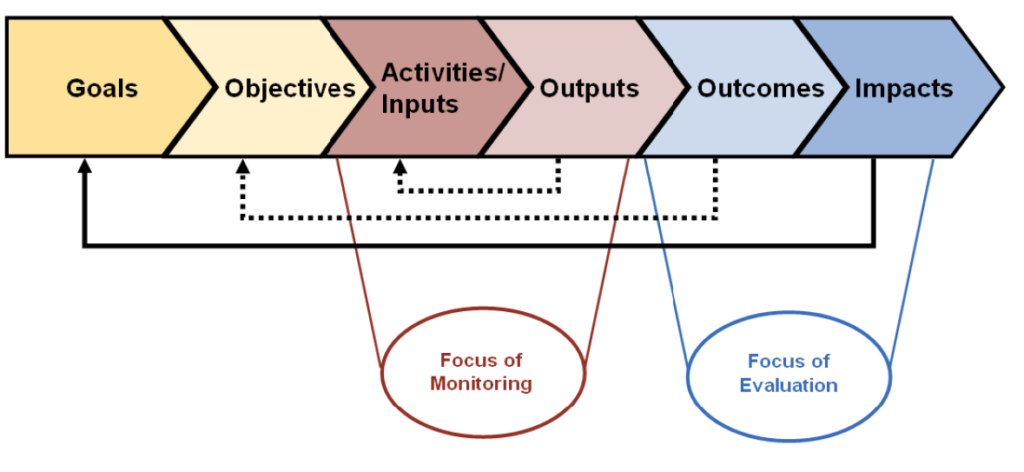The Monitoring and Evaluation framework for projects consists of monitoring of the progress and evaluation of the outputs. In other words, the monitoring components will mainly look at the inputs and outputs including activities, intermediate outputs, and to what degree outputs are implemented according to the planned activities.
On the other hand, the evaluation stage would be more interested in assessing the outcomes of the project. For example to what degree these outcomes were planned and desired. Here comes the impact assessment stage where project outcomes compare with the project goals and objectives.
While the monitoring would be interested in comparing outputs with inputs according to a plan. The evaluation would compare outputs with objectives as well as the impact with goals.
Monitoring and Evaluation Framework Diagram

The diagram provides the framework steps. Goals of the project can be to reduce unemployment, objectives can be giving people skills, and activities would be training programs. After these programs run, then you will get outputs. For example, training materials, courses, trainers, exams, among others. After that, people learn and gain new skills. These skills would be the outcomes of the projects once they translate into jobs. These jobs would be the impact of the project on these participants. The overall unemployment would drop by this person due to the project.
Monitoring and Evaluation Framework indicators
For effective Monitoring and Evaluation framework implementation. Indicators will assess progress and evaluate different levels. The following indicators provide examples of the different stages along with examples.
Results-level indicators
Evaluation indicators (outcome and impact indicators) look at the degree your project has achieved its results. Examples would be how much unemployment dropped among targetted communities.
Output-level indicators
While outputs are not results by themselves, but they are prerequisites for achieving results desired. Yet, they are important indicators within the logical framework to achieve the outcomes. For example, how many community members acquired new skills, or how many passed the new skill training programs.
Be careful!
Watch out!
The fact that output-level indicators are easy to develop and collect sometimes leads project managers to focus primarily on these even later in the project’s life.
Input-level indicators
Input indicators provide information on the resources going into the project. For example, how many hours of training were conducted, or how many participants attended a training? Normally, these indicators focus on project efficiency and effectiveness. The following two guiding questions can help in understanding the difference.
What level of inputs produced how many outputs (efficiency)?
What level of input was required to produce what results (effectiveness)?
Quality-management indicators
The quality management indicators is an important Monitoring and Evaluation activity. It helps in assessing the quality of inputs to produce outputs. The fact that training is conducted is important, the quality of trainers is a quality-management indicator.
Example of an impact assessment project. More information from here.
